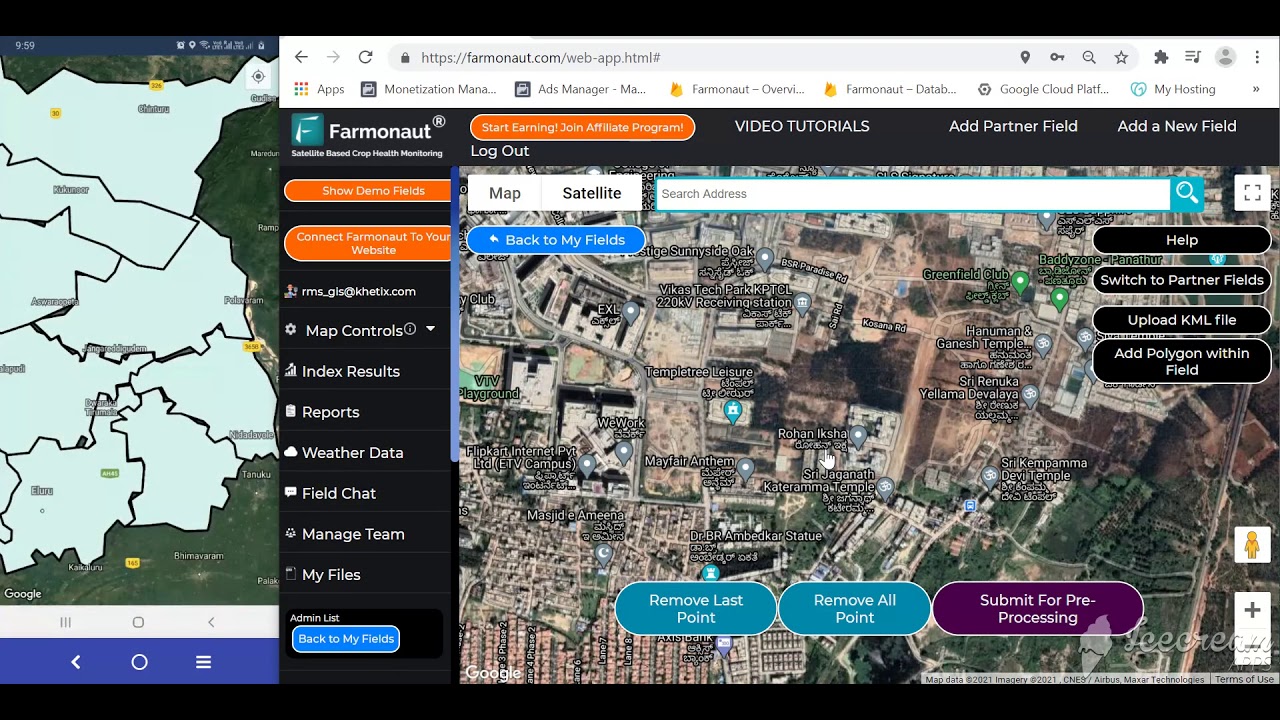Table of Contents
- Introduction: Understanding Black Bugs on Plants
- Agricultural Trivia: Crop Losses & IPM Success
- Common Black Bugs on Plants & Their Impact
- Comparison Table of Common Black Bug Pests
- Identification and Monitoring of Plant Pests
- 7 Proven Pest Control Tips for Black Bugs in Plants
- Farmonaut’s Role in Effective Pest Management
- Trivia: Power of Integrated Pest Management (IPM)
- Frequently Asked Questions (FAQ)
- Conclusion: Safeguarding Plants with Effective Pest Management
- Farmonaut Subscription Plans
Black Bugs in Plants: 7 Proven Pest Control Tips
Every grower, whether practicing agriculture, farming, or forestry, eventually encounters the challenge of black bugs on plants. These insects form a diverse group with significant impact on crop health and yield. The presence of black aphids on crops or other pest species is not only a sign of plant bug infestation but also a direct threat to the growth and sustainability of our food systems.
By focusing on identification of plant pests, understanding their life cycles, and implementing integrated pest management strategies (IPM), we empower ourselves to manage infestations, reduce damage, and ultimately protect our crops.
“Up to 30% of crop yield losses are caused by black bug infestations if left unmanaged in agriculture.”
Common Black Bugs on Plants & Their Impact on Agriculture
To achieve effective pest management, we must first recognize the common insect pests in farming and understand how their appearance, behavior, and feeding methods contribute to crop damage. Below, we explore the most prevalent black bugs on plants, with details to help with accurate identification and mitigation.
1. Black Bean Aphid (Aphis fabae)
The black bean aphid is a small, soft-bodied insect, roughly 2 millimeters long and typically colored black or dark green. It feeds on the sap of beans, sugar beets, celery, and other plants. Infestations may lead to stunted growth, distorted leaves, and reduced yields. In addition, these aphids excrete honeydew, promoting the formation of sooty mold that can hinder photosynthesis and further affect plant vigor.
- Host plants: Beans, sugar beets, celery, and more.
- Signs of infestation: Discolored or curled leaves; sticky honeydew on leaves; black sooty mold growth; visible clusters of small, black insects.
2. Black Grass Bug (Labops hesperius)
The black grass bug is a shiny black insect measuring about 0.2–0.33 inches. It primarily targets grasses but can also affect broadleaf plants. The feeding habit of this bug causes whitish or yellowish patches on leaves, which can result in reduced seed formation and, in severe cases, plant mortality.
- Host plants: Grasses, some broadleaf species.
- Signs of infestation: Patches of discolored leaves, especially lower foliage; decreased seed head formation; adult bugs visible on grass stems.
3. Black Vine Weevil (Otiorhynchus sulcatus)
The black vine weevil is prevalent in both Europe and North America. The adult is matte black, wingless (cannot fly), and feeds nocturnally, leaving notched edges on leaves. The larvae are creamy-white, live in the soil, and feed on roots and cambium at the base of trunks. Root destruction caused by them can result in severe plant death.
- Host plants: Ornamental shrubs, strawberries, rhododendrons, and other perennials.
- Signs of infestation: Notched leaves; wilting and stunted growth; poor root development; presence of larvae in soil.
4. Harlequin Cabbage Bug (Murgantia histrionica)
This black stinkbug, known as the harlequin cabbage bug, displays vivid red, orange, yellow, and white markings. It is a significant pest of cabbage and related crops, with both adults and nymphs feeding on stems and leaves. Feeding leads to leaf blotching, decreased vigor, and in heavy infestations, major yield reduction.
- Host plants: Cabbage, kale, mustard greens, and other brassicas.
- Signs of infestation: Irregularly colored or wilted leaves; dark bugs visible on plant stems; foul odor when bugs are disturbed.
5. Lygus Bugs (Lygus species)
The lygus bug group encompasses oval-shaped insects varying from pale green to black. They are notorious for piercing plant tissues and sucking sap, causing discoloration, shoot deformation, leaf curling, lesions, and, in some species, notable agricultural damage.
- Host plants: Alfalfa, strawberries, cotton, beans, and many weeds.
- Signs of infestation: Yellowing and curling leaves; stunted shoots; lesion formation on plant tissues.
Comparison Table of Common Black Bug Pests, Identification, and Control Methods
| Bug Name | Visual Description | Estimated Size (mm) | Typical Host Plants | Signs of Infestation | Estimated Damage Level (% Yield Loss) | Proven Control Methods (IPM Focus) |
|---|---|---|---|---|---|---|
| Black Bean Aphid (Aphis fabae) | Small, soft-bodied; black/dark green | 2–3 | Beans, sugar beets, celery | Curled leaves, honeydew, sooty mold | 5–40% | Crop rotation, ladybugs, insecticidal soap |
| Black Grass Bug (Labops hesperius) | Shiny black; elongated | 5–8 | Grasses, broadleaf plants | Whitish/yellow patches on leaves | 5–50% | Timely planting, weed removal |
| Black Vine Weevil (Otiorhynchus sulcatus) | Matte black; wingless adult; larvae creamy white | 5–10 (adults); 8–12 (larvae) | Ornamentals, strawberries | Notched leaves, wilted plants, root damage | 10–80% | Handpicking, nematodes, soil sanitation |
| Harlequin Cabbage Bug (Murgantia histrionica) | Black with red/orange/yellow/white markings | 6–9 | Cabbage, kale, mustard | Discolored leaves, visible bugs, odor | 10–70% | Crop residue removal, trap crops |
| Lygus Bug (Lygus spp.) | Oval, green to black; speedy movement | 4–6 | Alfalfa, cotton, strawberries, beans | Leaf spots, stunted growth, lesions | 5–25% | Early harvest, natural predators |
Identification and Monitoring: The Foundation of Effective Pest Management
Our ability to control black bugs on plants begins with accurate identification and regular monitoring. Missed or late identification of plant bug infestation signs can allow pests to multiply unchecked, resulting in extensive damage and more difficult eradication. Let’s explore essential steps for monitoring plant health and recognizing the presence of harmful insects.
Why is Identification Crucial?
The diverse group of black bugs encompasses various species with subtle differences in feeding pattern, appearance, and life cycles. Accurate identification of plant pests avoids unnecessary use of chemical controls and ensures we target the right insects with the most efficient strategies.
Plant Bug Infestation Signs to Watch For
- Discolored, mottled, or distorted leaves
- Stunted growth, poor seed/fruit formation
- Presence of honeydew or black sooty mold on leaves
- Holes, feeding notches, or lesions on foliage
- Clusters of visible bugs, larvae, or egg masses on stems and leaf undersides
- Wilting plants despite adequate water and soil conditions
Best Practices in Monitoring Plant Health
- Routine Inspection: Check crops weekly, paying special attention to growing tips, the underside of leaves, and the base of stems. Early detection is key to effective pest management.
- Use Technology: Farmonaut offers satellite-powered crop health monitoring tools that quickly highlight patches of stressed or infested crops at field scale. These remote sensing data complement traditional field scouting for a smarter, more efficient approach—helping us intervene before infestations escalate.
- Document Observations: Many pests have seasonal patterns. Track pest sightings and intervention outcomes on your farm logs or digital management system for trend analysis and future planning.
7 Proven Pest Control Tips for Black Bugs in Plants: Sustainable Strategies for Every Grower
Personalized and locally appropriate pest control in agriculture is essential for long-term productivity. Here are the seven proven approaches we recommend—compatible with any scale of farming and adaptable across crops:
1. Cultural Practices: Disrupt Pest Life Cycles Naturally
- Crop Rotation: Regularly changing your crop species prevents pests from thriving and breaking their life cycles. For instance, alternating beans with non-host cereals can limit aphid and weevil populations.
- Field Sanitation: Removing weeds and crop residues denies pests alternate habitats and overwintering sites. Clean fields reduce the likelihood of stubborn pest populations returning next season.
- Timely Planting: Sowing crops at recommended times helps ensure that young plants are not exposed to peak pest periods. For example, early- or late-planted fields may “escape” the window of major lygus bug emergence.
2. Mechanical Control: Physical Removal for Targeted Results
- Handpicking: In localized or early infestations, physically removing bugs, larvae, or egg clusters from plants can substantially reduce pest load.
- Water Sprays: A strong stream of water can dislodge aphids or other soft-bodied insects from leaves, reducing their numbers substantially without harming the plant.
3. Biological Pest Control Methods: Harness Nature’s Allies
- Preserve Natural Predators: Beneficial insects like ladybugs, lacewings, and parasitic wasps are voracious consumers of aphids, lygus bugs, and many pest larvae. Limit unnecessary chemical use to avoid harming these helpers.
- Biological Insecticides: Products containing natural pathogens (e.g., neem extracts, Bacillus thuringiensis) are highly specific and safer for both plants and the environment compared to synthetics.
4. Chemical Control: Use Judiciously, as a Last Resort
- Insecticidal Soaps: Especially effective against soft-bodied bugs like aphids, these are less damaging to natural predators and break down quickly in the environment.
- Systemic Insecticides: When pest pressure is overwhelming, carefully selected systemic chemicals can be used—but always according to label, crop, and regional regulations to minimize harm to pollinators and soil life.
Always check local guidelines and withdrawal periods when using chemical controls, especially for food crops.
5. Integrated Pest Management Strategies (IPM)
- Integrate Multiple Tactics: IPM involves blending cultural, biological, mechanical, and chemical tools based on ongoing monitoring and accurate identification of threats. IPM is proven to reduce overall pesticide use, lower resistance development, and support crop health.
- Regularly Assess Effectiveness: Adjust your strategy as pest populations and environmental conditions change, promoting long-term resilience in your plants and fields.
6. Use Remote Sensing & Digital Tools for Monitoring Plant Health
- Farmonaut’s Satellite Crop Health Monitoring: Quickly spot stressed or pest-damaged areas before visible symptoms with real-time, cost-effective satellite monitoring. NDVI imagery and soil moisture data can help us detect early indicators of damage from black bug infestations, optimizing our field scouting efforts and timely response.
- AI-Based Advisory: Use Farmonaut’s Jeevn AI tool for customized guidance and weather insights to predict peak pest activity windows.
7. Keep Reflective Mulches and Barriers
- Reflective Mulches: These can deter flying pests such as aphids and lygus bugs by confusing their navigation and repelling them from crops.
- Physical Barriers: Fine mesh or row covers over susceptible crops help keep bugs from accessing the plants, especially during vulnerable growth phases.
Farmonaut’s Role in Effective Pest Management & Sustainable Farming
As an agricultural technology leader, Farmonaut offers game-changing tools for pest control in agriculture, resource conservation, and data-backed management that are accessible via Android, iOS, web/browser apps, and API. Here’s how our platform addresses black bug infestations and supports growers worldwide:
- Satellite-Based Crop Health Monitoring: Monitor in real time across entire fields for early signs of pest hotspots with actionable NDVI, soil moisture, and vegetation stress alerts. Right intervention at the right time—reducing yield losses from bugs and minimizing cost.
- AI-Driven Advisory: Our Jeevn AI delivers field-specific pest advisories, growth forecasts, and expert IPM recommendations—drastically improving decision-making accuracy.
- Blockchain-Based Traceability: Enable full food and fiber supply chain traceability with secure, blockchain-powered records—critical for compliance, market access, and building consumer trust.
- Fleet and Resource Management: Efficiently plan farm machinery usage, minimize fuel consumption, and coordinate pest control operations over large-scale areas.
- Carbon Footprinting: Track your environmental impact and optimize inputs for sustainability and global compliance—beneficial for regulatory frameworks and eco-conscious markets.
- API Integration: Developers and businesses can directly access our satellite and weather data API or view developer documentation to embed these powerful data streams into custom solutions.
By choosing Farmonaut, smallholders, large-scale farms, governments, and agribusinesses gain a holistic, scalable digital infrastructure to prevent losses from black bugs on plants, maximize output, and ensure sustainable growth.
“Integrated Pest Management (IPM) can reduce black bug populations by over 60% using targeted, sustainable control methods.”
Frequently Asked Questions (FAQ): Black Bugs in Plants & Pest Management
Q1: Which black bugs are most harmful to crops?
While several species threaten global agriculture, the most significant yield loss is often caused by black bean aphid (Aphis fabae), black vine weevil (Otiorhynchus sulcatus), harlequin cabbage bug (Murgantia histrionica), and lygus bugs. Each pest has preferred hosts and unique damage patterns, making accurate identification vital.
Q2: How can I tell if my plants are affected by black aphids?
Look for clusters of tiny, dark insects on stems and the undersides of young leaves, presence of sticky honeydew, and black sooty mold. Curling or distortion of leaves also signals aphid infestation.
Q3: What’s the best way to prevent black bug infestations?
Combining crop rotation, regular monitoring, field sanitation, use of beneficial insects (biological controls), and only resorting to chemicals as a last option exemplifies integrated pest management strategies. Using Farmonaut’s crop monitoring further strengthens your prevention efforts.
Q4: Are chemical pesticides safe for all pests and crops?
Not all chemicals work equally on every pest, and overuse can harm pollinators, beneficial organisms, and the environment. Always follow label guidelines, assess the pest species involved, and incorporate IPM principles for the most balanced results.
Q5: How does remote sensing help with pest control?
Satellite crop monitoring with solutions like Farmonaut allows us to identify changes in crop vigor or stress remotely, often before visible symptoms. This enables prompt scouting, confirmation, and intervention to address pest damage at field scale.
Conclusion: Safeguarding Plant Health with Proven Black Bug Pest Control
Black bugs on plants are a critical threat to agriculture, farming, and forestry globally. Their damage can be severe and diverse, ranging from yield loss in field crops to the complete decline of sensitive ornamentals. However, with vigilant identification of plant pests, robust monitoring, and a commitment to integrated pest management strategies, we give our plants the very best chance to thrive.
In summary, we recommend:
- Prioritizing crop health monitoring with digital and field-based systems like those from Farmonaut.
- Embracing cultural, mechanical, and biological pest control methods for long-term sustainability.
- Limiting chemical interventions to targeted, necessary applications—always within an IPM framework.
- Continuously educating ourselves about pest species, life cycles, and local infestation timing.
By following these seven proven pest control tips, powered by data-driven insights and the latest agricultural technologies, we can overcome even the toughest black bug infestations and secure healthy, profitable harvests year after year.
Farmonaut Subscription Plans
Get started with Farmonaut’s flexible, affordable digital tools and revolutionize your pest management, farm resource allocation, and sustainable practices today!





















